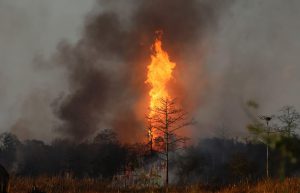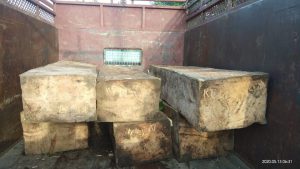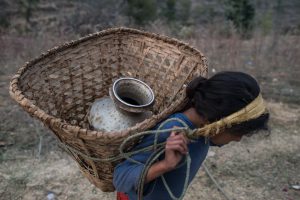Around 800 families in eastern Assam have been evacuated from their homes after a gas well blew out in Baghjan village on May 27 – leading to an uncontrolled release of natural gas as the well’s pressure control systems failed. The next day, doctors had to be called to the nearby school to which the residents had been moved, as elderly evacuees complained of breathing difficulties due to oil vapours and natural gas in the air.
Located in Tinsukia district of Assam in north-eastern India, Baghjan is in the middle of some of the world’s top biodiversity hotspots – to its north is the confluence of three rivers that together form the Brahmaputra, with the Dibru-Saikhowa National Park just across a narrow arm of the river; to the south is the Maguri-Motapung wetland, a famous ecotourism spot. Panic in the area increased after the carcass of an endangered Gangetic dolphin was found in the wetland two days after the blowout.
Oil leakage is an old problem, but this is the first time we are witnessing such a big disaster. We warned the government but no one cares.Devajit Moran, secretary of local NGO Green Bud
Operated by Oil India Limited (OIL), the rig “DGR – Location 5”, blew out with a huge blast at 10:24 am on May 27, according to Hemanta Moran, a 38-year-old schoolteacher in Baghjan. This was followed by a loud hissing noise. Moran ran out of his house and saw a cloud of gas and a rain of oil. He also saw OIL workers running hither and thither.
Moran said the news spread at once and residents started running to evacuate the village.
“It was no less than a doomsday sight in our village,” Moran told The Third Pole. “The trees, the roofs of houses, our farms, everything is covered with oil. It’s all shining.”
![The rig spewing out gas through some trees, three days after the blowout [image by: Binanda Hatibaruah]](https://dialogue.earth/content/uploads/2020/05/Baghjan-oil-blowout-inside-pic-credit-Binanda-Hatibaruah.jpg)
Residents of Baghjan and the nearby village Dighaltarang were evacuated to Baghjan government ME school premises. Despite the ongoing nationwide lockdown due to the Covid-19 pandemic, there was no space to maintain safe distance between the people now living inside the school building.
Over the next two days, two women fainted after complaining of breathing difficulties. That was when a team of doctors was called in. “Because of Covid-19 the villagers fear going to hospitals,” Moran said.
The authorities react
Dharmendra Pradhan, India’s minister for petroleum and natural gas, said in a statement two days after the blowout that he had discussed the situation with the heads of OIL as well as of the Oil and Natural Gas Commission (ONGC). He had advised OIL to take all necessary steps to ensure the health and safety of the local population and had instructed ONGC to provide all possible support to OIL, the minister added.
Describing the blowout as a “very serious issue,” Chandra Mohan Patwary, a minister and the spokesperson of the Assam state government, said that Pradhan would be visiting Assam with the heads of OIL and ONGC, and the state government had asked its pollution control board personnel to accompany the minister to the site. “They will try to take control of the situation.”
Experts from ONGC are already helping OIL at the spot. By May 30, the evacuation zone had been extended to a radius of 1.5 kilometre from the well, and another shelter was being set up. OIL is ensuring food and logistics support, according to local reports.
Damage to ecology
Diplob, a 30-year-old environmentalist, has been raising his voice since 2008 against drilling in this eco-sensitive area, famous for being a habitat of the endangered Hoolock Gibbon conservation. Residents say the number of gibbons in the area has dropped from 37 in 2016 to probably 12. “Now, the leaves of the trees on which the gibbons live are covered with oil. We fear they may unknowingly eat those leaves,” Diplob said.
In his own tea garden, the plants are now covered with chemicals and oil. “Several agricultural fields have been destroyed, fish are dying in the water, there is no fodder for our livestock as it’s covered with oil,” he added.
The area is home to some rare birds including the critically endangered Baer’s Pochard and the White Bellied Heron.
See a multimedia report: In Assam, a wetland too popular for its own good
Devajit Moran, secretary of local NGO Green Bud, said, “Oil leakage is an old problem, but this is the first time we are witnessing such a big disaster. We warned the government but no one cares. More than 15,000 people here are fishers. The rest are farmers. The oil has formed a layer on the water and the soil. It will take 2-3 years for nature to recover from this. Every piece of land has become uncultivatable now.”
Two student groups, the All Moran Students’ Union and Assam Jatiyatabadi Yuba Chhatra Parishad, have demanded a probe into the incident. “Our organisation along with other local people and organisations have been protesting against environmental clearance to Oil India Limited by the union ministry of environment, forest and climate change for extensive drilling and hydrocarbon testing at seven locations inside Dibru-Saikhowa National Park for a long time” said Debojit Moran, a leader of the students’ union. “But it seems the higher authorities will never listen.”
Environmentalists all over the country have protested the drilling clearance, which was given during the lockdown forced by Covid-19. Local activists say if there had been no lockdown, there would have been more protests on the ground.
Correction: An earlier version of this article said an oil well had exploded instead of a gas well. This was corrected on July 2. The Third Pole regrets the error
![<p>Oil covers the water of the Maguri-Motapung wetland near the site where a well blew out on May 27 [image by: Binanda Hatibaruah]</p>](https://dialogue.earth/content/uploads/2020/05/Assam-gas-well-blows-.jpeg)








